Part 4: Getting the Best out of a Micro Snow Stove Mk15
This article is in four parts:
- Part 1: A Micro Wood Burning Stove For Alpine Tents – Dream or Virtual Reality?
- Part 2: Micro Snow Stove Mk 15 For Alpine Camping
- Part 3: Using Micro Snow Stove Mk 15
- Part 4: Getting The Best Out of a Micro Snow Stove Mk 15 – The Dream Becomes a Reality
Introduction
Please read this article in context of the previous three articles. Article 1 is about my dream of an ultra-lightweight heat source when skiing and snow camping and my lessons from failures. It also tells how I was teased and spurred on by the amazing protracted and intense heat energy that is released by the efficient combustion of a hand full of bush sticks. The second article is about my best stove so far, the Micro Snow Stove Mk15, that largely met all my defined requirements. The third article is about the very important basics of safely and effectively using the stove under field conditions that are invariably difficult and when heat from a stove matters most. Now this fourth article is about supplementary DIY tools to take and make in the bush when using the stove and also safety, care and maintenance issues.
Tools, What I Take and What I Make In The Bush
DIY Bow Saw
I made this simple little saw from part of the leg of a discarded aluminium beach chair, and a small bush saw blade. It weighs only 5.29 oz. (150 g) and is a serious wood cutting instrument that is easy to make.
Modified Anvil-secateurs
My favorite secateurs are the anvil type (rather than bypass cutters) from Aldi, and they weigh 8.47 oz. (240 g). I replace the plastic anvil with a stronger one made from a 1.65 in. (42 mm) long piece of aluminium “L” section. I hold the replacement anvil in place by a steel rivet salvaged from a beach chair. Lastly, the anvil is shaped to match the shape of the original plastic one.


Splitting Knife
I use those cheap TV steak knives “…..yes, but wait; there’s more type that are found in every op-shop…” and grind off the teeth to leave a smooth, sharp blade that I use as my regular camping knife. I make a blade guard out of a flattened piece of ½” (12.7 mm) poly pipe. I make sure the metal of the knife is good quality, not too hard to be brittle, not too soft as to bend, and capable of holding a good sharp edge (it should be able to cut out a bean can lid and still be sharp enough to pair wood easily). Lastly, give it a good workout splitting wood at home to test its quality before taking it on a trip. My splitting knife doubles as my general purpose knife for fishing etc., and cooking knife, so it adds no extra weight. I find a quality knife with a riveted handle (as shown above) is much more long lasting than those with molded plastic handles that crack easily with the impact of splitting.
Wood Sawing Stop
I use a spring head roofing nail (rather stout and not easily bent) and drive it into a suitable sloping branch on a tree (using the wooden mallet) to make a safe sawing stop for efficiently cutting fire wood billets etc.
Bush Mallet and Wood Splitting Anvil
I cut a solid piece 15.75*1.97-2.36 in. (400*50-60 mm) diameter section of branch to use as a bush mallet (for wood splitting, etc.) and another bigger piece to use as a wood splitting anvil inside the tent. In bad weather, a warm tent is the best place to split and prepare the fire wood sticks, and I drive the splitting anvil deeply into the snow at a convenient location in the tent. The location should be such that it is comfortable to work at while sitting in the pit, but not too close to things that could damaged by a “miss-hit” or the action of the bush mallet.
I staple some hay band loops to the wooden tools and hang them in the snow gums to use during my next visit. As my father taught me, I take a little care with making these hand tools as this makes them safer, more functional, and comfortable to use. Also, when left hanging above the high snow level at a campsite they are usually respected as tools and are there for my next visit.
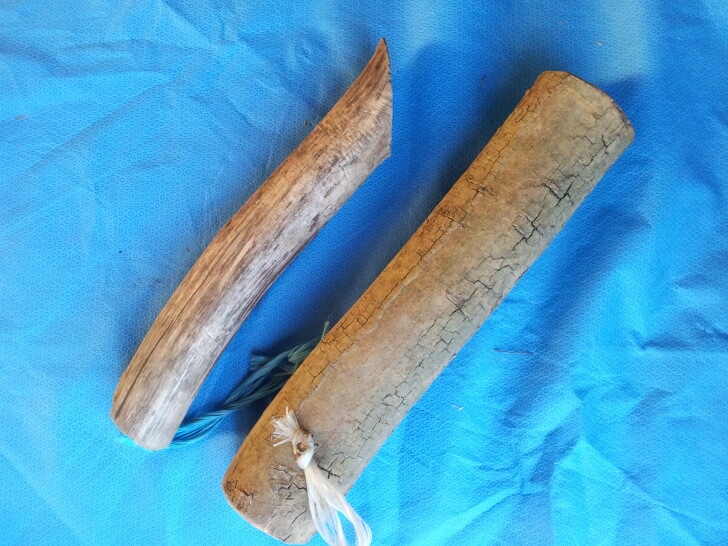
Bush Stove Mounting Pole
I cut a point on the bottom end to make it better to drive into snow and soil. I finish the top end by paring it down a 1.18 in. (30 mm) diameter, allowing for removal of bark (it should be a tight fit in the stove mounting socket). Now I can hear some of you saying “the stove heat is going to char the post top”. The answer is “no” and I do a careful test of the temperature of the socket that goes over the post. I should always be able to touch the mounting socket with my forefinger and feel no pain. The socket has such a large surface area for radiating heat and such a thin connection of stainless steel (which is a very poor conductor) that it does not get hot.
Tool Hangers
The very small tools that I use with the stove are easily misplaced or lost, so a selected twig or laterals on a wooden tent pole can be used to safely and systematically hang the tools ready for use.
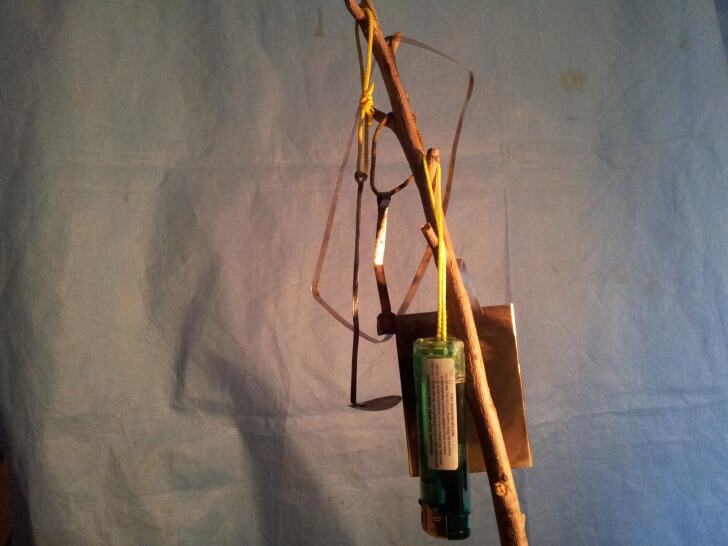
Wood Drying Rack
I select two straight branches of ~ 236.57*.98-1.57 in. (~ 600 *25-40 mm) diameter for the drying rack frame while collecting fire wood billets. I split these branches to make two longitudinal and about seven cross beams to dock to suitable lengths with the secateurs. The drying rack hangers have loops of ~ .98 in. (~25 mm) diameter on the lower ends. These are designed to receive two cross sticks through the loops.
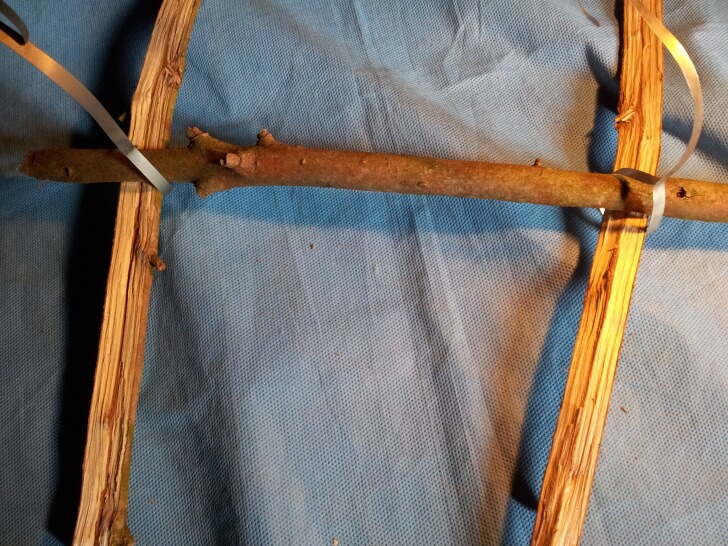
After placing the cross beams in place, I like to put some cooking foil on the rack to reflect radiated heat back. It also provides a storage/drying space for all sorts of small wood pieces that come about from preparing fuel sticks, and these are always handy for stove management. It is a bit of a fiddle fitting the foil around the stove stabilizing strut, but in my experience, it is well worth it, particularly when base camping for multiple nights at the one site.
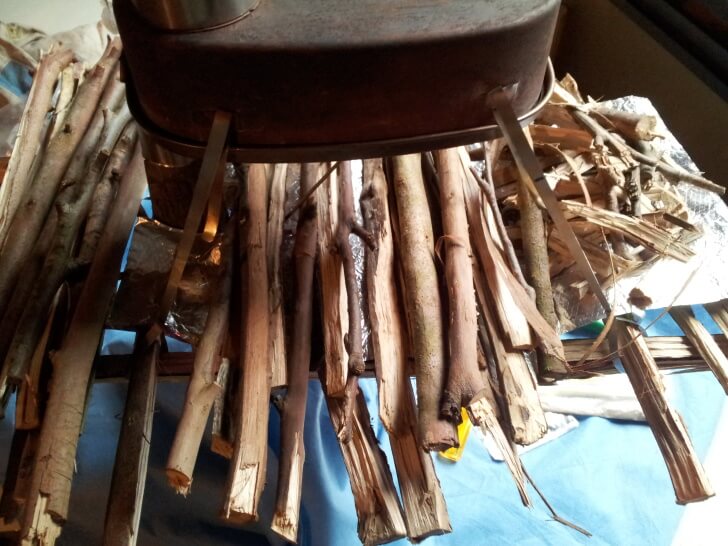
Tent Lighting
Winter gives us short days, and if you are like me, you ski all day and come back to the tent only when you must. This means that most of your time in the tent with the stove burning will be night time. Consequently, good lighting is critical for running and managing the stove. The stove can provide some nice light through the burner glass, and enough light to see that your mates are laughing at your jokes. However, supplementary lighting will be needed.
I use a very small overhead LED lamp hung from the tent apex and carry back up lights including solar powered ones. I find that tea light candles do not work well or at all when snow camping. The wax will not melt enough, and the wick goes without molten wax. The wick material burns away. My modified turbo ceramic candle is an interesting alternative, but that is a story for another day.
Preparation of Waxies
I cut multiple sheets of newspaper into strips that are about 3.94 in. (100 mm) wide. Then I roll them up together in a coil and tie a string around the circumference to hold the coil together and form an “extraction handle.” I get an old saucepan from the op-shop and melt down old candles or jam wax so that I can flood the paper roll with wax. I lower the coil of paper in and let it become saturated with wax. Using the string, I remove the paper slowly from the wax allowing it to drain back into the pot. Then I quickly put the roll on some more newspaper sheets and quickly peal the layers apart while the wax is still warm. I spread the individual strips out separately to cool on the newspaper. When the strips are cooled I bundle up about ten strips and cut off at intervals of about .79 in. (20 mm) to make the finished waxies.
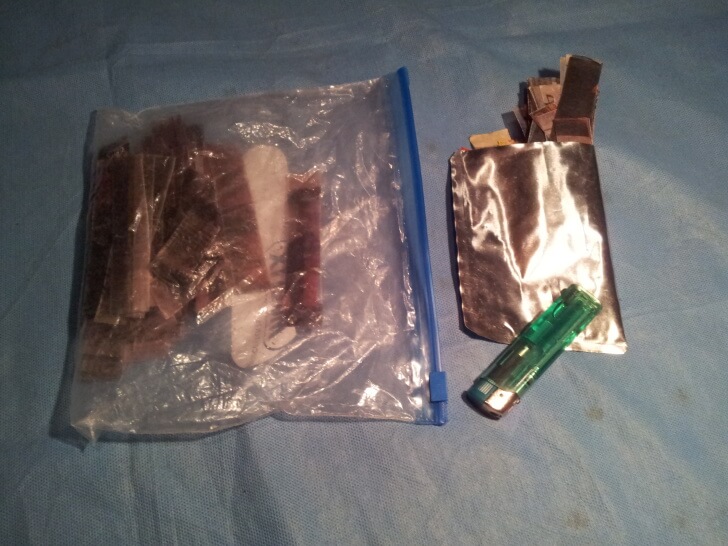
Great Fire Starters- But They Stink
Having extolled the virtues of waxies, it grieves me to admit that apart from some thick Eucalyptus bark soaked in wax I have found no better fire starter than the commercial white fire starter blocks that many people use to start household wood fired heaters. A small piece/s (1 cc volume) will easily start the micro stove if there is adequate fine tinder to kindle the burn. I think both the success of the fire starter, and the fragility of the flame of the fire starter is due to the slow release of the hydrocarbon fuel from the white matrix (that is not really that flammable). It provides protracted gentle burning and for this reason, it is superior to waxies that burn much brighter, but for a much shorter time. The fragile burn of the fire starter means that you must light it in place because if it is first lit and then dropped into place, the shock will extinguish the flame. So this is where a long nose lighter or preferably a waxie is needed to gently start the burning of the fire starter that is normally out of reach of a normal match stick or lighter flames.
Now I have the bad news. The hydrocarbon in fire starters permeates most available small plastic containers. The escaping vapor can easily contaminate food in your pack and quickly diminish the burning value of the fire starter. For this reason I use an aluminium M&B style screw cap container (hard to find these days). Or, preferably, I use a blood glucose test strip tube, or an aluminium Berocca tube, and cover the plastic press-in lids with an aluminium cooking foil membrane to stop the hydrocarbons from escaping through the lid. This may sound a bit iffy, but it works well, and the glucose test strip tube is thin enough and short enough to fit inside the rolled up 78.74 in. (2,000 mm) flue pipe to still leave room for the primary air port valve assembly to also fit inside while backpacking (described later). I also find it best to cut up the fire starter at home with a sharp knife. This way they can be cut into sizes that will fit efficiently inside the tube and be ready for immediate use. I find that blocks of about .39*.39*.20 in. (10*10*5 mm) fit efficiently in these small tubes and more or less can be used according to the quality of starter wood chips.

Sifted Ash Supply
I use fine ash to form an air seal around the joint between the stove body and the inverted access lid. At home, I use a fine metal sieve to obtain a small supply of fine ash dust. I put about four teaspoons full into a small zippy bag, and this will last a long time as it takes very little to fill the crack. It is worth sieving as it will pack into the seal better. Fine soil will also do the job if you forget the ash.
Member Exclusive
A Premium or Unlimited Membership* is required to view the rest of this article.
* A Basic Membership is required to view Member Q&A events

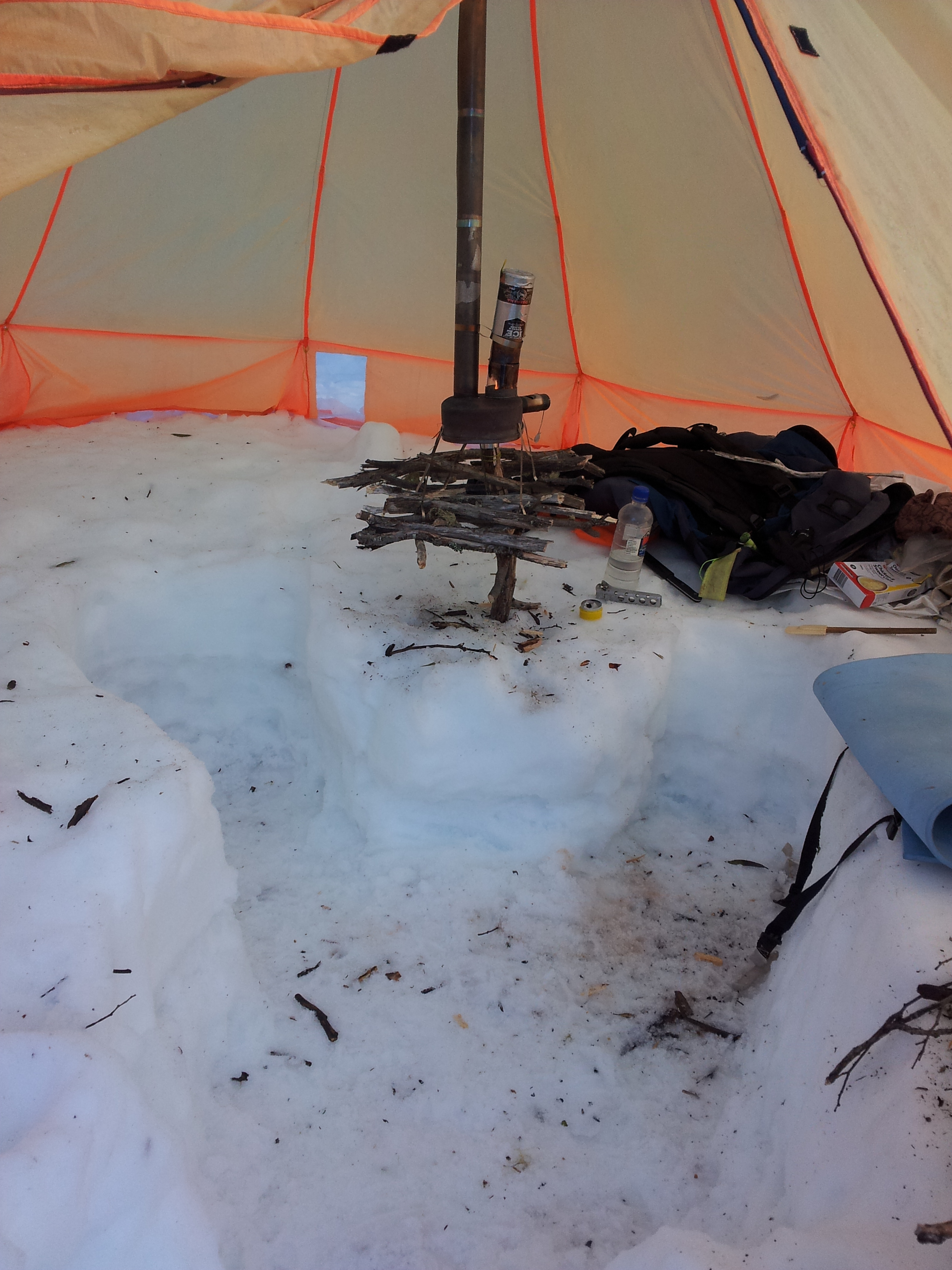


Home › Forums › Backpacking Wood Stove for Alpine/Snow Camping, Part 4: Dream Becomes Reality